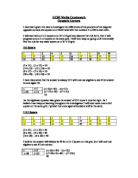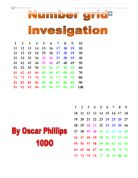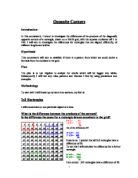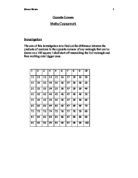Investigate the relationships between the numbers in the crosses.
GCSE Maths Coursework 2 - Assessment A01 Aim * To investigate the relationships between the numbers in the crosses. Hypotheses * I predict that several connections will be found, which will help relate to crosses in a 100 square grid. * I predict that were ever the cross is on the grid that the result will always be the same, for each cross. * I predict that when the cross is changed, that the original equation will still apply but with a division number. * That knowing one number on the cross that all others are able to be found by adding or subtracting a fixed number. Original cross 36 74 a 45 46 47 83 84 85 d x b 56 94 c Rule: * (Left x right number) - (top x bottom number) = 99 * This rule states that if a cross is situated anywhere on a grid, then the left number multiplied by the right number subtract the top number multiplied by the bottom number always gives the number 99. Proof: * (45 x 47) - (36 x 56) = 99 * (87 x 85) - (74 x 94) = 99 Equation: * (d x b) - (a x c) = 99 * This algebraic equation shows that were ever the cross is situated on the grid that the put come of the left number multiplied by the right number subtract the top number multiplied by the bottom number always
In this project I hope to achieve the ability to explain how and why certain formulae can be associated with this particular problem. I also hope to extend the investigation in order to find interesting patterns, which can be relevant to the task.
In this project I hope to achieve the ability to explain how and why certain formulae can be associated with this particular problem. I also hope to extend the investigation in order to find interesting patterns, which can be relevant to the task. The main variables that can be experimented with are: - The number of colours used to shade the rectangle The number of squares shaded in the rectangle The number of squares in the rectangle In order to investigate the problem thoroughly, it is sensible to only change one variable at a time whilst keeping the others constant. First let's investigate with the number of colours shaded, keeping the number of squares in the rectangle at 6. We will use a different colour each time so that the total number of colours used remains at 6 as well. With 1 colour: There are 6 places in which the red square can be placed. Therefore there are 6 combinations With 2 colours: There are 6 places in which the red square can be placed. Once it is fixed and cannot move, there are 5 remaining places that the blue square can be placed. Therefore there are 6 ? 5 = 30 combinations With 3 colours: There are 6 places in which the red square can be placed and 5 remaining places that the yellow square can be placed. Once both colours are fixed, there are 4 remaining places that the yellow square can be placed. Therefore there are 6 ? 5 ? 4
Routes On Polyhedra
Routes On Polyhedra My objective is to find out a rule for how a number of routes change on a polyhedra as the number of edges on the bottom face of the shape changes. Cuboid For this cuboid shape,I would have to find All the routes from the * at A to the . at G. My method for the cuboid in the diagram above is to start at A (*) and then find all the routes that began A-B, then all the routes that began A-D and finally A-E. I came up with 16 different routes. Triangular Prism I am going to show you all the routes that the triangular prism has within it. I start with the A to B combinations and the The A to C and finally A-E No of edges on the bottom face Number of rout 3 1/12 4 5/16 5 9/20 6 23/24 These prism polyhedra's fit the rule 4n or 4n-1 because N=No. of edges on bottom face. = 4 X number of edges on the bottom face Pyramid My system is the same as described in the method This square based pyramid has 7 routes The rule for pyramids is 2n-1 Edges on bottom face Number of routes 3 5 4 7 Both the pyramids and prisms amount of routes are numerically connected to the number of edges on the bottom face of the shape. 6 routes form B-Z A-Z D-Z And 15 routes form C-Z This means that the total amount of Routes is 63. When adding two shapes together we add all the possible routes from the different points on the shape. All the
Investigating Number Stairs
Maths Coursework(c) - Investigating Number Stairs Part 1 46 36 37 26 27 28 To investigate the relationship of other 3-step stairs, their stair total and their position on the grid, we can move it one space to the right. We then get the following in the 10x10grid: 26+27+28+36+37+46=200 Therefore total = 200 If we continue moving the shape to the right, and continue this for each row on the grid, we get a pattern like this: 2 3 4 5 94 200 206 212 218 S+20 S+10 S+11 S S+1 S+2 We can say that it increases in a linear fashion (the increase is constant). To use a formula to find out the stair total every time, we can make use of the bottom left had corner of the stair and change it to S. Every other number can be changed so that it is related to S So the total for any 3-step stair on the 10x10 grid= 6S+44 We can test this formula for the very first grid we did: (6x25) + (44) = 194 So OK! Part 2 To investigate the relationship of the 3-step stair on a 11x11 and a 12x12 we have to modify the step stair: S+21 S+11 S+12 S S+1 S+2 S+22 S+12 S+13 S S+1 S+2 So we get 6S+ 47 for 11x11 and 6S+49 for 12x12 Since we have the formulae for 10x10, 11x11 and 12x12, we can make a general formula for finding the stair total for a 3-step stair for any grid size. We can do this since it increases in a linear fashion (+2 every time). We get the formulae:
Investigating three step stairs.
Aim I am set the task of investigating three step stairs (which I will go into some more detail on later on) and how their position on the number grid and the step total corresponds to the step number. Prediction My basic prediction is that... Definitions Step total - the total of all the numbers in the stair added up Stair number - this is the lowest number in the stair and is found in the bottom left hand corner of them Number grid - this is a ten by ten square with the numbers from one to one hundred in it as ten time ten is 100. The ten by ten grid is the grid we will be using in the first part of the investigation but in the second stage of the investigation other smaller and larger number grids will be tested. Step number - this is the number of steps the stair is comprised of. As I have stated the step number I will be using for the main part for this investigation will be a three step stair, with a three step number there will be six numbers within the stair. Establishing a connection In order to establish a link between n (n=stair number) and the st (st=step total) I must conduct a series of tests on various different three step stairs in different positions on the ten by ten grid. I will, whilst examining the results I gain from different stairs, attempt to find a formula that can be used to predict the st of any
Maths Gridwork
Introduction In this investigation, I have been asked to investigate on a number grid that is 10 wide and 10 descending. We have been asked to test the equation (Top left x Bottom right) - (Top right x Bottom left) on grids varying in size, starting at 2x2, then on to 3x3 and so on. I will describe the constraints of the equation and explain the algebraic rule that determines the end outcome of the grid. I will then relate my new formula and describe how it can be related with rectangles. I will then find a formula that will suit a Master grid. A diagram of the number grid is shown below: 2 3 4 5 6 7 8 9 0 1 2 3 4 5 6 7 8 9 20 21 22 23 24 25 26 27 28 29 30 31 32 33 34 35 36 37 38 39 40 41 42 43 44 45 46 47 48 49 50 51 52 53 54 55 56 57 58 59 60 61 62 63 64 65 66 67 68 69 70 71 72 73 74 75 76 77 78 79 80 81 82 83 84 85 86 87 88 89 90 91 92 93 94 95 96 97 98 99 00 2*2 squares Equation: (TL*BR)-(TR*BL) Example 1 22 23 32 33 (22*33)- (23*32) = -10 Example 2 37 38 47 48 (37*48)- (38*47) = -10 Example 3 57 58 67 68 (57*68)- (58*67) = -10 Example 4 2 2 1 (1*12)- (2*11) = -10 I predict that with all 2*2 grid squares the equation will always produce an answer of -10 Example5 56 57 66 67 (56*67)- (57*66) = -10 I will now use algebra to prove my theory.
Marked on the grid is a stair shape; this is called a 3-Step Stair.The total of the numbers inside the stair shape is:
NUMBER STAIRS This is a 10 by 10 Number Grid: 91 92 93 94 95 96 97 98 99 00 81 82 83 84 85 86 87 88 89 90 71 72 73 74 75 76 77 78 79 80 61 62 63 64 65 66 67 68 69 70 51 52 53 54 55 56 57 58 59 60 41 42 43 44 45 46 47 48 49 50 31 32 33 34 35 36 37 38 39 40 21 22 23 24 25 26 27 28 29 30 1 2 3 4 5 6 7 8 9 20 2 3 4 5 6 7 8 9 0 Fig. 1 Marked on the grid is a stair shape; this is called a 3-Step Stair. The total of the numbers inside the stair shape is: 25 + 26 + 27 + 35 + 36 + 45 = 194 The Stair Total for this 3-step stair is 194. Part 1 For other 3-step stairs, investigate the relationship between the stair total and the position of the stair shape on the grid. Part 2 Investigate further the relationship between the stair totals and other step stairs on other number grids. 4w+1 4w+2 4w+3 4w+4 5w 3w+1 3w+2 3w+3 3w+4 4w 2w+1 2w+2 2w+3 2w+4 3w w+1 w+2 w+3 w+4 2w 0w+1 0w+2 0w+3 0w+4 w w = width Fig. 1 On every size of number grid the formula in each block above will be the right formula for the corresponding number on any grid. However, on larger or smaller number grids some blocks may not exist or more blocks may exist. The formulae in the furthest right hand side column are always in the furthest right hand side column on every size of grid as
I have been asked to investigate further into the stair totals and other step stairs on different number grids. Firstly, I will change the sizes of the stairs from 3 steps to 4, then 5, and so on to 8 step stairs.
Maths coursework - part two In part two, I have been asked to investigate further into the stair totals and other step stairs on different number grids. Firstly, I will change the sizes of the stairs from 3 steps to 4, then 5, and so on to 8 step stairs. When I have finished investigating that, I will change the sizes of the grids. I will also try to find the nth term for the nth term. So I can use it to find it the nth terms of any sized step stairs, or any three step stair on any grid. 4 step stairs Stair number = 1 Stair total = 120 31 32 33 34 21 22 23 24 1 2 3 4 2 3 4 Stair number = 2 Stair total = 130 32 33 34 354 22 23 24 25 2 3 4 5 2 3 4 5 Stair number = 3 Stair total = 140 33 34 35 36 23 24 25 26 3 4 5 6 3 4 5 6 A table to show the stair numbers And stair totals Stair no 2 3 Stair total 20 30 40 Finding the nth term 0 20 30 20 130 140 +10 +10 +10 0n + 110 = stair total Checking the nth term for stair 4 0n + 110 (10 x 4) +110 40 + 110 50 = stair total for stair number 4 5 step stairs Stair number = 1 Stair total = 235 41 42 43 44 45 31 32 33 34 35 21 22 23 24 25 1 2 3 4 5 2 3 4 5 Stair number = 2 Stair total= 250 42 43 44 45 46 32 33 34 35 36 22 23 24 25 26 2 3 4 5 6 2 3 4 5 6 Stair number = 3 Stair total = 265 43 44 45 46 47
As Australia is one of the most popular tourist destinations in the world it is necessary to observe the tourist precincts Australia has to offer.
As Australia is one of the most popular tourist destinations in the world it is necessary to observe the tourist precincts Australia has to offer. The objective and purpose of this report is to outline and comment on the main tourist precincts in the Melbourne CBD area including Southbank and Federation Square. The first and one of the major tourist places, which is an attraction all over the world, is the recently built Federation Square. The square commemorates 100 years as Australia as a colony from 1901 to 2001. The square has very good access to both public transport and the public. It is directly opposite Flinders Street Station, Melbourne's central rail station, and trams also run along the side of the square for easy access. The place is built on a flat area including ramps for disabled members. There is also a towards the rail station and a great number of seating around the whole complex which is normally a common area for business workers at lunch time that work around the area. There is lots of signage around the square and also a small information booth at the front corner of the square for information of where anything is situated and a general overview of what's happening in the square and around the city. One of the major attractions within the square is the art gallery. It is a great place for tourists to visit and explore the art inside Melbourne.
Investigation 1-Square shaped pieces of card
Investigation 1-Square shaped pieces of card Aim- To find the length of the cut-out corners that gives the maximum volume for the open box formed by any sized piece of square card. The length of the cut out will be given to three significant figures of accuracy. Method- I will investigate what length of cut-out corners will give the largest volume of square pieces of card with dimensions of 12x12, 18x18, 24x24 and 30x30. Note- When "length", "breadth" and "height" are mentioned, they refer to the dimensions of an open box. When "volume" is mentioned, it refers to the volume of an open box. Height is also the same as to the size of the cut-out corners of an open box. I am going to begin by investigating a square with a side length of 12 cm. Using this side length, the maximum whole number I can cut off each corner is 5cm, as otherwise I would not have any box left. I am going to begin by looking into whole numbers being cut out of the box corners. The formula that needs to be used to get the volume of a box is: Volume = Length * Width * Height If I am to use a square of side length 12cm, then I can calculate the side lengths minus the cut out squares using the following equation. Volume = Length - (2 * Cut Out) * Width - (2 * Cut Out) * Height Using a square, both the length & the width are



























